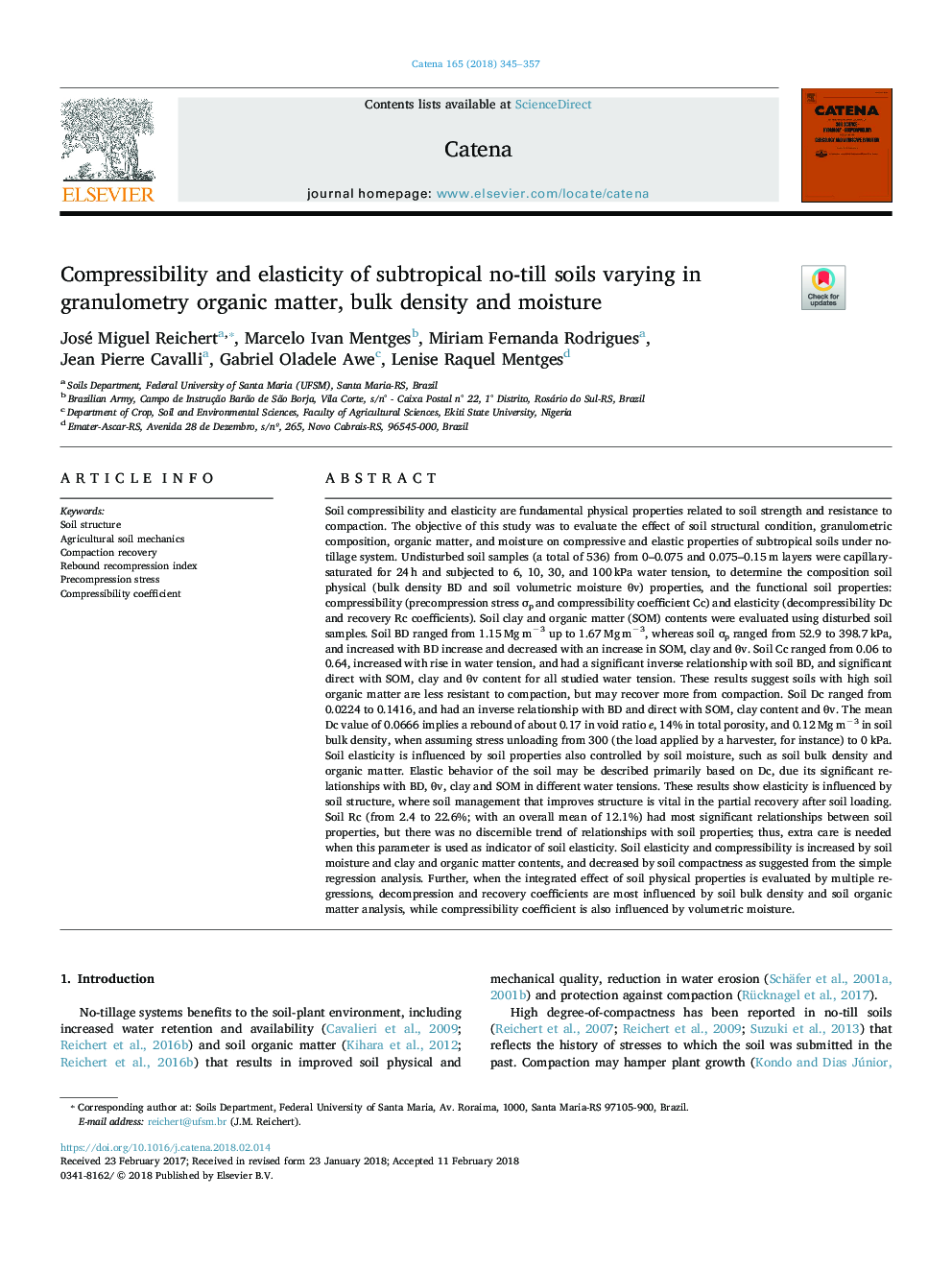| کد مقاله | کد نشریه | سال انتشار | مقاله انگلیسی | نسخه تمام متن |
|---|---|---|---|---|
| 8893607 | 1629189 | 2018 | 13 صفحه PDF | دانلود رایگان |
عنوان انگلیسی مقاله ISI
Compressibility and elasticity of subtropical no-till soils varying in granulometry organic matter, bulk density and moisture
ترجمه فارسی عنوان
فشرده سازی و الاستیسیته خاک های نیمه گرمسیری بدون تغییر در مواد آلی گرانولتری، تراکم فشرده و
دانلود مقاله + سفارش ترجمه
دانلود مقاله ISI انگلیسی
رایگان برای ایرانیان
کلمات کلیدی
ساختار خاک، مکانیک خاک کشاورزی، بازیابی ضخامت شاخص بازتوزیع عقب، استرس قبل از برداشتن، ضریب فشرده سازی،
موضوعات مرتبط
مهندسی و علوم پایه
علوم زمین و سیارات
فرآیندهای سطح زمین
چکیده انگلیسی
Soil compressibility and elasticity are fundamental physical properties related to soil strength and resistance to compaction. The objective of this study was to evaluate the effect of soil structural condition, granulometric composition, organic matter, and moisture on compressive and elastic properties of subtropical soils under no-tillage system. Undisturbed soil samples (a total of 536) from 0-0.075 and 0.075-0.15â¯m layers were capillary-saturated for 24â¯h and subjected to 6, 10, 30, and 100â¯kPa water tension, to determine the composition soil physical (bulk density BD and soil volumetric moisture θv) properties, and the functional soil properties: compressibility (precompression stress Ïp and compressibility coefficient Cc) and elasticity (decompressibility Dc and recovery Rc coefficients). Soil clay and organic matter (SOM) contents were evaluated using disturbed soil samples. Soil BD ranged from 1.15â¯Mgâ¯mâ3 up to 1.67â¯Mgâ¯mâ3, whereas soil Ïp ranged from 52.9 to 398.7â¯kPa, and increased with BD increase and decreased with an increase in SOM, clay and θv. Soil Cc ranged from 0.06 to 0.64, increased with rise in water tension, and had a significant inverse relationship with soil BD, and significant direct with SOM, clay and θv content for all studied water tension. These results suggest soils with high soil organic matter are less resistant to compaction, but may recover more from compaction. Soil Dc ranged from 0.0224 to 0.1416, and had an inverse relationship with BD and direct with SOM, clay content and θv. The mean Dc value of 0.0666 implies a rebound of about 0.17 in void ratio e, 14% in total porosity, and 0.12â¯Mgâ¯mâ3 in soil bulk density, when assuming stress unloading from 300 (the load applied by a harvester, for instance) to 0â¯kPa. Soil elasticity is influenced by soil properties also controlled by soil moisture, such as soil bulk density and organic matter. Elastic behavior of the soil may be described primarily based on Dc, due its significant relationships with BD, θv, clay and SOM in different water tensions. These results show elasticity is influenced by soil structure, where soil management that improves structure is vital in the partial recovery after soil loading. Soil Rc (from 2.4 to 22.6%; with an overall mean of 12.1%) had most significant relationships between soil properties, but there was no discernible trend of relationships with soil properties; thus, extra care is needed when this parameter is used as indicator of soil elasticity. Soil elasticity and compressibility is increased by soil moisture and clay and organic matter contents, and decreased by soil compactness as suggested from the simple regression analysis. Further, when the integrated effect of soil physical properties is evaluated by multiple regressions, decompression and recovery coefficients are most influenced by soil bulk density and soil organic matter analysis, while compressibility coefficient is also influenced by volumetric moisture.
ناشر
Database: Elsevier - ScienceDirect (ساینس دایرکت)
Journal: CATENA - Volume 165, June 2018, Pages 345-357
Journal: CATENA - Volume 165, June 2018, Pages 345-357
نویسندگان
José Miguel Reichert, Marcelo Ivan Mentges, Miriam Fernanda Rodrigues, Jean Pierre Cavalli, Gabriel Oladele Awe, Lenise Raquel Mentges,
